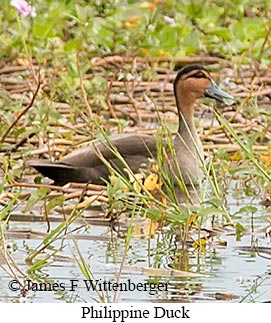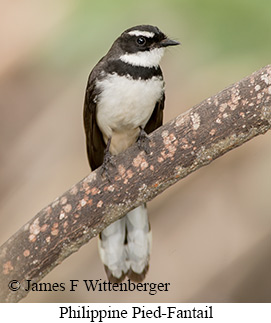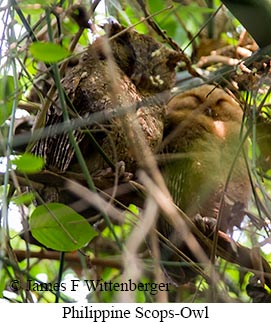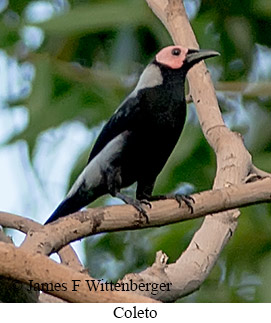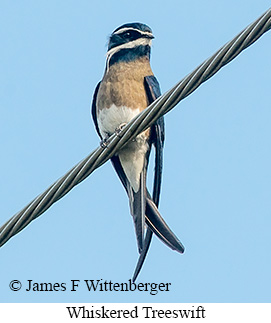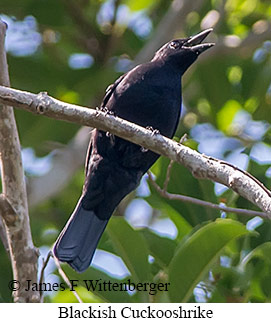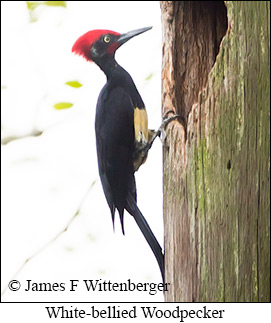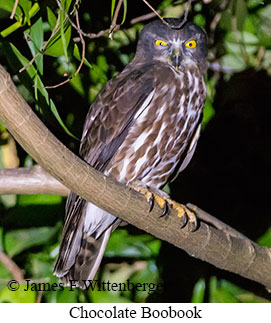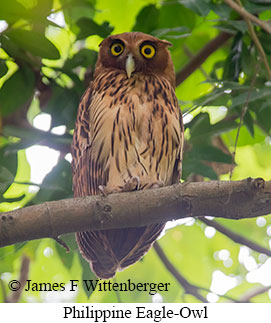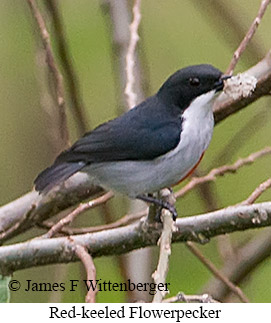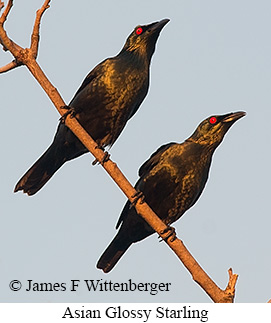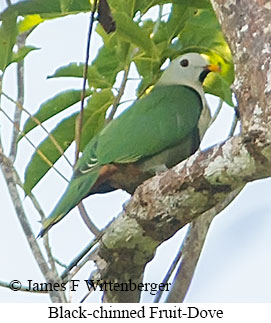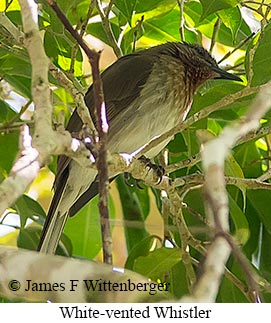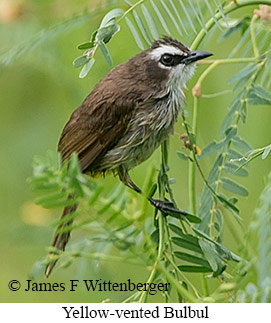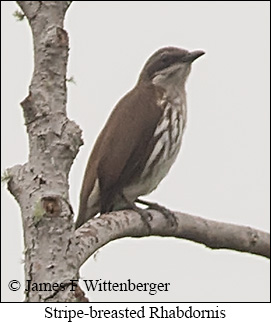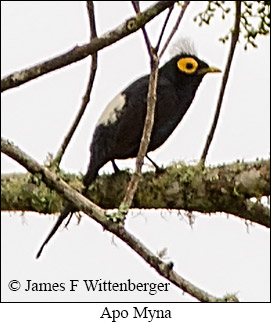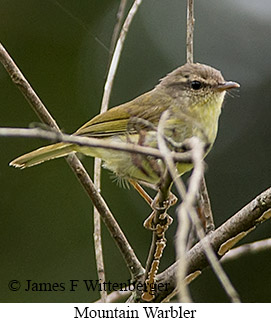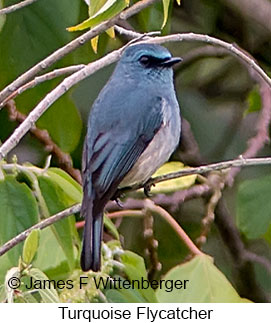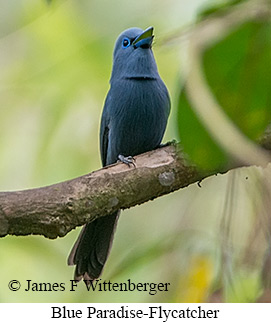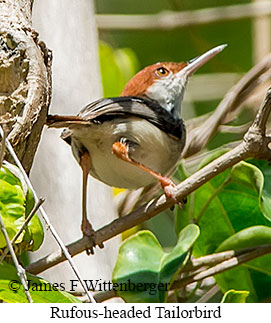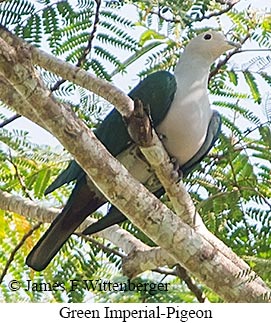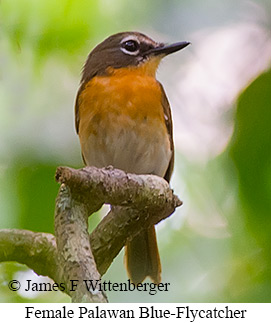PHILIPPINES BIRDING TRIP REPORT

TRIP REPORT
PHILIPPINES
| Start: | 01/30/2016 |
| End: | 02/18/2016 |
| Duration: | 20 days |
| #Species: | 266 |
| #Endemics: | 116 |
| #Heard Only: | 6 |
2016 Philippines Birding Tour
TOUR DESCRIPTION
I joined a tour to the Philippines conducted by Birding2Asia since the dates worked for me and I'm interested in scouting the country with the idea of Exotic Birding offering tours there. Multiple guides were used for the tour. Five British people, including one now living in Australia, were on the tour besides myself. Most were quite advanced world birders. In general, the other participants were not happy with some of the logistics, the several changes to itinerary, and the accommodations. They felt that the latter did not live up to the description on the company's website. The birding was slow throughout the tour, probably due to an El Niño effect or perhaps just on-going climate change that evidently affected birding throughout southeast Asia.
Jan 30: Three of us arrived a day early. Graham Ekins from Britain arranged for a local guide to take us out to Candaba Wetlands. We left the hotel at 3:45am, a very good idea since it took just 30 min to reach our meeting point with the guide. Later, it would have taken 2 hours due to the always very heavy traffic in Manila. Candaba is currently very threatened by conversion of wetlands in the area to rice fields, but at this time it still has some good habitat for wetland birds. Certainly the most exciting find was a female teal with all the markings of Baikal Teal. We sent photos to the Philippines records committee, which confirmed the identification. Males of this species show up once in a while, but females almost never appear in the Philippines. We had good views of Philippine Crake and Barred Rail, the latter quite common. Some people also saw Buff-banded Rail, which I missed. Candaba is especially noted for the large number of Philippine Ducks found there, about 60% of the world population. Other interesting species we saw included Wandering Whistling-Duck, Cinnamon Bittern, Philippine Swamphen, Oriental Pratincole, Blue-tailed Bee-eater, Philippine Pied-Fantail, and Short-tailed Starling. After lunch we drove to the University of Philippines campus for a stakeout of Philippine Scops-Owl. We saw an adult and fledged young hidden up in tall, dense bamboo. We also found a roosting Philippine Nightjar and had distant views of Philippine Woodpecker, a split from Gray-capped Woodpecker. Our guide dropped us on a main thoroughfare and contacted a taxi to take us back to the hotel. The taxi ride took 2 hours due to heavy traffic. Manila is very bad in that regard.
Jan 31: Our actual tour began at 5:30am. By then traffic was heavy so it took quite a long time to reach our first birding site, La Mesa Eco-park. Since it was Sunday the park was very busy and crowded with people. Our main target bird, Gray Ground-Thrush was nowhere to be seen. It's the first time our guide missed seeing the bird there. We did pick up some other birds of interest in the park, including Glossy Swiftlet, Collared Kingfisher, White-bellied Kingfisher, Pied Triller, Gray-backed Tailorbird, Gray-streaked Flycatcher, Philippine Magpie-Robin, Pygmy Flowerpecker, and Lowland White-eye. Some people also saw Ameline Swiftlet, which I missed. From there we drove to Candaba Wetlands, another time-consuming drive due to heavy traffic. Fewer birds were present than the day before, apparently because a hunter was shooting in the area. The most significant new bird was Black Bittern. We also saw White-breasted Waterhen that was missed the day before. From there we headed to Subic Naval Base, wanting to spend a couple hours there before dark. Due to the heavy traffic, we didn't arrive until 5:30pm. In the waning light we had very good views of two Coletos. We also had good but distant views of Whiskered Treeswift atop a distant tree and White-breasted Woodswallow on a fairly distant wire.
Feb 1: After early breakfast, we drove to the Botanical Gardens, where we birded along an old asphalt military road used during World War II for access to concrete bunkers. An early highlight was a Yellow-vented Fruit-Dove perched high in a distant tree but quite open. We had excellent views of Red-keeled Flowerpecker flitting about in a low tree along the road. One of the bunkers was full of Glossy Swiftlets, which seem to nest in ventilation holes around the inner walls of the bunker. We had distant views of Luzon Flameback, a recent split from Greater Flameback, as well as Sooty Woodpecker and White-bellied Woodpecker. We saw Luzon Hornbills both morning and afternoon. We saw and photographed Bar-bellied Cuckooshrikes high up in a mostly leafless tree along the road. Some of us got a very good look at Blackish Cuckooshrike as well. We had good views of Whiskered Treeswift perched in a tree and later flying overhead. We also saw White-breasted Woodswallows flying around above us. We had a fly-by of a juvenile Rufous-bellied Eagle and also Philippine Cuckoo-Dove. As we were eating a snack before proceeding to our next spot, we saw a Philippine Hawk-Eagle fly by. We then spotted three Philippine Serpent-Eagles soaring high above but unfortunately flying away from us. On our way back to the hotel for lunch we stopped to view and photograph a half dozen trees filled with large fruit bats, Golden-crested Flying Foxes and Philippine Flying Foxes. Quite spectacular seeing them all hanging on bare tree limbs right in the open.
After lunch and a break we birded the access road to Kamana Beach and Sanctuary. On our way there we stopped to photograph Brown-breasted Kingfisher perched in the open and were soon distracted by Blue-naped Parrots high in a tree, followed by Elegant Tit and Japanese Leaf-Warbler, a split from Arctic Warbler, in another nearby tree. While milling around we spotted a White-bellied Sea-Eagle flying across the open parking area before disappearing behind the trees. Finally reaching the Kamana access road, we quickly spotted a troop of Crab-eating Monkeys on the road. We had very good though somewhat distant views of Red-crested Malkoha, which wouldn't show earlier in the day. We also had scope views of Chestnut Bee-eaters perched atop a distant tree. A pair of Sooty Woodpeckers were spotted fairly close on a tall limbless stump. These then flew to a tree in the back. In the same trees we found Tarictic Hornbills, which then flew to and perched in the open atop the "bee-eater" tree before flying across the road. We saw a pair of Balicassiao fly across the road in front of us. We tried hard for Rufous Coucal, a secretive bird that rarely comes open. One bird did drop down for extremely brief views. We drove a bit farther downhill and took a side road where we found a Guaiabero perched nicely in a tree. We heard Rufous Coucals again, but only the guide saw them quite briefly. In the same spot we had decent views of White-rumped Shama perched deep in very dark undergrowth just before dusk. We then spotted a White-bellied Woodpecker on a telephone pole not far from us, where it had a nesting hole. It was returning to roost in the hole, which we watched it do. At dusk we went looking for owls and found Philippine Boobook. We heard Philippine Scops-Owl but couldn't see it, except for a couple people in the group who saw a silhouette of it fly across the road. As we departed for our hotel we spotted a Chocolate Boobook on a wire near the road. It soon flew to some trees farther back, allowing us to get out of the vehicle without scaring it. We all had fabulous views of the bird perched in the open - a very good end to the day.
Feb 2: We started early again and were after mainly a few target birds we'd missed the previous day. We soon saw two of them, Green Racquet-tail and Stripe-sided Rhabdornis, the first showing well high in a nearby tree and the second (about 5 birds) quite far away in a treetop. More difficult was our third target, Trilling Tailorbird. We heard it singing fairly near us in dense underbrush, but it took quite some time to actually locate one. The bird stayed in a thick tangle but we finally saw it all piece-meal (ie. not the entire bird at any one time). Other interesting birds included very good looks at Brahminy Kite soaring overhead, Philippine Serpent-Eagle perched and soaring, a very distant perched Philippine Falconet, White-eared Dove showing well, very good looks at the spectacular Scale-crested Malkoha, and good looks at Blackish Cuckooshrike. In the afternoon we returned to the same area we visited the previous afternoon. It was hot and sunny so bird activity was very low. We did see another Philippine Serpent-Eagle land and sit perched for some time in a distant tree. The best bird was a female Spotted Kingfisher, which took some doing to spot deep in thick mid-story canopy in late afternoon. At dusk we had several Great Eared-Nightjars flying above the valley. After dark we heard Philippine Hawk-Eagle but didn't see it. We hoped to see Philippine Scops-Owl, but there was no sign of any.
Feb 3: In early morning we returned to Jest Camp to look for missing species. Aside from birds seen on previous days, the only new one was Purple Needletail. We had better but still distant views of Stripe-breasted Rhabdornis. We also had better views and a photo op of Red-crested Malkoha in a bush along the road. We left Subic for Mt Makiling at 11:00am. The traffic was horrible as usual. We went an hour and a half out of our way to the Andogan Pteroglyph Park, a stakeout for Philippine Eagle-Owl, which we found perched in the open in some fairly low canopy upon exiting the entrance tunnel into the park. It offered wonderful photo ops and views. We then continued driving to Makiling through more heavy traffic, escaping the horrible traffic only on the toll road. We arrived after dark at 7:00pm.
Feb 4: We left early for University of the Philippines at Makiling. We spent much of the morning walking up a partly paved roadway through good forest. The morning started overcast and drizzly, but the drizzle at least stopped before we started birding. We walked up the roadway for a couple hours. Bird activity was unusually low. We did find Yellow-wattled Bulbul soon enough, but after that not much other than hornbills until we found a flowering tree full of birds. There we saw Stripe-breasted Rhabdornis, Flaming Sunbird, Striped Flowerpecker, Red-keeled Flowerpecker, and Ashy Minivet. Farther up the road we had a short but excellent look at Philippine Trogon perched in the open before it flew. In the afternoon we went back over to University of the Philippines Los Banos campus where we hoped to see Spotted Buttonquail, which occasionally crosses a gravel side road in the agricultural complex. However, we were ejected by a campus police officer. Our guide went to the police office but could not get permission to walk that road for some reason. Still worse, we could only walk around the area if we didn't carry our cameras or take photos - some kind of power play by the local police. We therefore unfortunately missed excellent photo ops of Gray-cheeked Buzzard, Barred Rail, and Tawny Grassbird. We also saw some other birds well including Cinnamon Bittern but never the buttonquail. The day was overall a disappointment as we missed several important target species.
Feb 5: In early morning we returned to the road up Mt Makiling in hopes of picking up species missed the previous day. It was sunny and warm, resulting in even less bird activity than the day before. No new species were seen except Buzzing Flowerpecker seen by some. At 8:00am sharp when the botanical gardens opened, we were there. Our one target bird was Indigo-banded Kingfisher, a very wary and rather hard to see forest kingfisher that can sometimes be seen along the stream there. We checked carefully along the stream, and at the last possible spot we saw one sitting on a rock mid-stream. Everyone got excellent looks but no photos were possible as the bird immediately flew when we attempted to find a way to photograph it. From there we transferred to the airport in Manila for our flight to Bohol. We arrived at the hotel about 4:30pm. After check-in, we walked to the town square where we saw several hundred Asian Glossy-Starlings staging in open trees before going to roost.
Feb 6: We were up early and drove to Rajah Sikatuna National Park where we spent all day except for lunch in the Chocolate Hills nearby. In the clearing we saw numerous Pygmy Swiftlets and a couple Samar Hornbills. Our hoped for Silvery Kingfisher was not around its usual haunts, though it had been before we arrived. We did see it later with a bit of searching along a river en route to lunch. We flushed an Everett's Scops-Owl from a shed where it had been roosting, but only a couple people got on it where the bird was perched after flying out of the shed. We had excellent views of a pair of Striated Wren-Babblers (formerly called Striated Ground-Babblers). In the same area we had very nice looks at the often hard to see Yellow-breasted Tailorbird. The guide also saw Rufous-fronted Tailorbird. Also in the same area, we had a mixed flock come through and stay awhile, allowing everyone to pick up Japanese Leaf-Warbler (a recent split from Arctic Warbler), Philippine Leaf-Warbler, Black-naped Monarch, Yellow-bellied Whistler, Brown Tit-Babbler, and Red-keeled Flowerpecker. The guide also saw Orange-bellied Flowerpecker in the same flock. We had a quick view of Buff-spotted Flameback as it flew through the forest and disappeared. We had a clear view of the often difficult to see Philippine Oriole perched directly overhead. After lunch we saw fleeting views of Amethyst Pigeon and a female Philippine Trogon hidden deep in the understory. The hoped for Steere's Pitta, a recent split from Red-bellied Pitta, was nowhere evident despite numerous attempts at playback. They weren't calling, unusual for this time of year. We arrived back at the hotel about 7:00pm following an hour and a half drive from the national park.
Feb 7: We intended to get an even earlier start from the hotel to try for Steere's Pitta again. However, our driver was 20min late so we wound up leaving about the same time as the day before. We hoped to get Rufous-lored Kingfisher from the clearing where we parked, but no luck. Walking a trail through the forest, we soon heard Rufous-tailed Jungle-Flycatcher, a tiny and secretive bird that eventually everyone was able to see as it flitted about in mid-story canopy. We continued on and soon heard Rufous-lored Kingfisher calling. After an hour or more of total frustration, one person in the group saw it through a very tiny window in trees behind. No one else ever saw it. Bird activity was extremely minimal, and we spent the rest of the morning seeing and hearing virtually nothing. We stopped en route to the restaurant to try for Bohol Sunbird. Our local guide saw it but no one else did. Lunch at the butterfly farm was uneventful but took an inordinately long time as it was a Sunday and also Chinese New Year, so lots of people were there. After lunch we went to the Tarsier Centre where we had very nice views of wild Philippine Tarsiers roosting inside a fenced enclosure that is open above. In the clearing behind the visitor center we eventually had a fabulous though distant views of Black-chinned Fruit-Dove, a bird ordinarily difficult to see due to its usual wariness in response to hunting pressure. We also had a brief but excellent look at Yellow-wattled Bulbul in the clearing and a short look at Yellow-breasted Fruit-Dove as it flew overhead. We heard Philippine Coucal, a quite wary and shy bird, but couldn't see it. As we left the center, we had one fly directly overhead for good flight views.
Feb 8: We had one last morning on Bohol to try for missing target birds, especially Steere's Pitta and Visayan Broadbill. We spent the morning looking for both. No sign of either. It's a late spring and bird activity is very low compared to normal. The pittas should be singing but we did not hear a single one. The broadbill is a flock follower and a matter of luck to see. We failed to flush Everett's Scops-Owl from the shed. One participant crawled into a limestone cave where one was known to roost and saw it but flushed it deeper into the cave where no one else could see it. Aside from that we had much better views of Rufous Jungle-Flycatcher than the day before and also saw Besra, Philippine Trogon (deep in the forest), Samar Hornbill, Buff-spotted Flameback, and Purple-throated Sunbird. In late morning we departed for the airport to catch our 2:00pm flight to Cebu. We arrived at our hotel at 5:00pm. Several people had problems with the sanitary condition of their rooms and internet access was not available. The group decided to change hotels after looking around the area, and we got checked in to the new place at 7:30pm. Our guide graciously picked up the tab for the new hotel even though the rooms at the other one were already paid for, but later the tour operator required everyone to pay for the change of rooms. People were not at all happy about that.
Feb 9: Cebu is worth visiting for a few target species. Over 99.5% of the original forest is gone, and it takes close to 3 hours to reach good forest from Cebu City. We rose early and did that drive. Our first stop was a site where Cebu Boobook had been seen before on previous tours. We played the tape and one person saw an owl fly rapidly away without ever getting a good look. We tried to see it later in the morning near the forest ranger's home, where he said it often roosts, but failed to find it. The best plan for the owl is to be there shortly after dark, which is difficult given the distance to Cebu City. While looking for the owl we did see a number of other birds, notably Philippine Bulbul, Philippine Magpie-Robin, White-vented Whistler, one of our target birds that we also saw farther up the road, Elegant Tit, Handsome Sunbird, Magnificent Sunbird, the latter two being target birds on Cebu as well, and Everett's White-eye. Farther up the same road, which has frequent motorbike traffic, we saw White-eared Dove, a likely future split to become Buff-eared Dove, through a narrow window into forest canopy. In late morning we had excellent looks at Gray-faced Buzzard soaring above before disappearing. About 1:00pm we headed down the mountain with the intention of eating lunch at a German resort hotel not far from the birding area. However, they had no food available, so we had to drive another 45min to reach a restaurant in the lowlands owned by the same German family. Service was incredibly slow, even by Philippine standards, so we didn't actually head back to Cebu City until 4:00pm. We stopped en route to look at a few waders and then continued to our hotel, arriving shortly after 7:00pm. Participants on the tour were very unhappy that we were staying in Cebu City instead of near the national park, causing us to miss the owl. The tour operator said the hotel near the park was unreliable and often didn't honor reservations.
Feb10: We left Cebu City for the airport at 5:30am to beat the traffic, arriving in good time only to learn our flight was delayed 20min. After a one hour flight followed by a 3 hour drive through traffic and road construction, we transferred to the back of a flatbed truck for an additional 6 km drive through rural farming plots. From there it's a considerable hike uphill to Del Monte Lodge, located in a clearing at the beginning of good forest. On the way up we did see Philippine Needletail, Philippine Bulbul, Yellow-vented Bulbul, Eyebrowed Thrush, Elegant Tit, and Short-tailed Starling. Some also had good views of Mountain White-eye, which turns out to be a very common bird higher up. At the lodge a flock of Cinnamon Ibon came through a large tree at the edge of the clearing. It was late afternoon, overcast, and a bit drizzly so it was hard to see color most of the time. After dusk we heard Mindanao Eagle-Owl quite close to the lodge. However, it failed to respond to playback and was not seen. The lodge itself is very rustic with no electricity or internet access. Sleeping is either in tents pitched under a large tarp or on the floor of the upstairs on mats. They do have flush toilets, the only real amenity.
Feb 11: Up early for breakfast at 5:00am with the idea of birding around the clearing before hiking up the trail to look for Philippine Eagle. The morning dawned cloudy and a bit drizzly, and for the most part it didn't improve during the day. We hiked and birded our way uphill for 4 hours to the observation area where Philippine Eagle is most likely seen. However, with fog and drizzle prevalent, the eagles weren't flying and hence not seen. On the way up we had a good scope view of Philippine Cuckoo-Dove. We also saw the very secretive White-browed Shortwing when it flew across the trail from one dense thicket to another. We had excellent views of Stripe-breasted Rhabdornis on several occasions. We also had good scope views of Apo Myna. We saw several bird flocks on the way up and at the observation spot including large flocks of wintering Eyebrowed Thrush feeding on fruiting trees. We had two Brahminy Kites fly over while hoping for the weather to improve. We also had a group of about ten Mindanao Raquet-tails fly over the valley below. We had a very nice though somewhat distant view of MacGregor's Cuckooshrike perched in a bare tree. In the various mixed species flocks we saw during the day, Mountain White-eyes were most prevalent. Other birds seen in flocks included Philippine Woodpecker, Mountain Warbler, Philippine Leaf-Warbler, Mugimaki Flycatcher, Little Pied-Flycatcher, Turquoise Flycatcher-Flycatcher, Black-and-Cinnamon Fantail, Elegant Tit, Sulphur-billed Nuthatch, Gray-hooded Sunbird, Olive-capped Flowerpecker, Fire-breasted Flowerpecker, and Cinnamon Ibon. At dusk we went out looking for night birds and had a very close fly-by of Bukidnon Woodcock and an overhead flyover of Philippine Nightjar.
Feb 12: The day dawned with more promising weather. The stars had been out and the morning was mostly clear. It boded well for raptors flying, so we hiked up to the viewing site without much birding, taking about an hour and a half to get there. We then spent the next 7½ hours hoping to see a Philippine Eagle, unfortunately with no success. During that time overcast had set in and fog enveloped the hilltops for a time. We did see several Oriental Honey-Buzzards and a couple Brahminy Kites. Aside from that we didn't see anything we hadn't seen the day before and in fact saw less. In late afternoon we saw a Buff-spotted Woodpecker from the dining area of the lodge. Both groups preceding us this year saw the eagle, as did all but one group the previous year. We just did not have good fortune despite two days of trying. After dinner when the rain had stopped, we went out looking for night birds and quickly found Philippine Nightjar. We had great views as it perched on a branch and called in our spotlight.
Feb 13: We had to leave the lodge fairly early to eventually reach the airport for our flight back to Manila. It was overcast and raining off and on while going down the trail from the lodge. We did a small amount of birding on the way down and picked up Gray-capped Sunbird that I had missed the previous days. We also saw Rufous-headed Tailorbird, a skulker that was hard to see in dense understory in the rain. I saw it as it flew across the trail and flitted about but never got good looks. A couple other people saw it perched in gray light in the drizzle. We hiked down the trail, which took about an hour and a half, loaded our gear on a flatbed truck for the bumpy drive to the main road, and then drove through heavy traffic much of the time toward the airport. We stopped for famed cinnamon buns at one restaurant and later on at a Filipino restaurant for lunch. We arrived at the airport in good time and managed to get on an earlier flight than our scheduled 4:30pm flight to Manila. Flights were delayed due to delays in Manila, which is typical, but we arrived by 5:00pm thanks to our earlier departure from Cagayan de Oro. A fairly short taxi ride got us to the hotel before 5:30pm.
Feb 14: We took an early flight to Puerto Princesa on Palowan. The original schedule was to go to Sabang the first two nights and bird around Puerto Princesa the last two nights. However, this got reversed, which was extremely upsetting to several participants because they had scheduled mid-day departures on the last day on the assumption we would be near town. Instead they would miss a morning of birding around Sabang. In any case, after arrival we birded the road and picked up Chestnut Malkoha, Brown-backed Needletail, Rufous-backed Dwarf-Kingfisher, Philippine Pied-Fantail, Slender-billed Crow, Ashy-fronted Bulbul, Rufous-headed Tailorbird, Pygmy Flowerpecker, and Plain-throated Sunbird. Some people saw Copper-throated Sunbird near mangroves on the coast. After lunch we visited a forest area where we walked several side trails. There we had good views of White-vented Shama, Blue Paradise-Flycatcher and the secretive Palowan Babbler. We remained out until after dark to look for Spotted Wood-Owl and Palowan Frogmouth. Neither were found. We got back to the hotel about 9:30pm after stopping for dinner in a local restaurant. Again, participants were unhappy because we stayed in a different hotel than the one on the itinerary. The later had closed 3 months earlier, but the change had never been communicated to anyone.
Feb 15: Up early for all day birding around Puerto Princesa. During early morning we picked up many of our target species, namely Palawan Tit, Black-headed Bulbul, Rufous-headed Tailorbird, Yellow-throated Leafbird, Lovely Sunbird, and Pale Spiderhunter. We had excellent looks at a pair of Spot-throated Flamebacks, a recent split from Common Flameback, and had a flyover of Crested Goshawk. We spent much of the morning trying for Palowan Flycatcher, a secretive and difficult species to see. One person in the group managed to get a glimpse of one. In the afternoon we tried some more for Palowan Flycatcher and the same person saw it again. The rest of us missed it. We had a good look at an immature Blue-headed Racket-tail, a parrot that is rarely seen perched. Near dusk we took a boat out to a small island where we eventually saw the poorly known Mantanani Scops-Owl. I saw it fly up into the trees in the dark, and then we saw the back end of it where it perched before flying away.
Feb 16: Up early as usual with breakfast at 5:30am. We had a good start to birding along the roadside not far from our hotel. We soon picked up Green Imperial-Pigeon, Asian Koel, Fiery Minivet, Gray-throated Bulbul, and Pin-striped Tit-Babbler . We also saw a Rufous-bellied Eagle soaring high overhead. As it got hotter, by 9:30am, birding drastically slowed down. I saw two Common Hill Mynas missed by everyone else. We quit for lunch about 10:30am as we were not seeing any activity. By then it was very hot and sunny. At 3:00pm we went back out, with our main target birds being Red-necked Flameback and Sulphur-bellied Bulbul. We missed on both. We did see more Common Hill-Mynas and some other birds seen previously on the tour. We also flushed a Barred Buttonquail along a road, seen by only a couple people. In late afternoon we climbed up to a viewpoint to look for Philippine Cockatoos and quickly found two perched. We wound up having distant but good scope views plus 4 individuals flying across the valley. This species is in severe decline due mainly to the cage bird trade. At the same spot we had an extremely distant scope view of two Great Slaty Woodpeckers. After dark we went to a new site our guide thought would be good for Palowan Scops-Owl, and he was right. We all had wonderful views of a perched bird. We then drove up the road to a likely spot for Palowan Frogmouth and it didn't take long to find one for good views as well. We arrived back at the hotel about 8:00pm.
Feb 17: As always, we were up early. We had made special arrangements to visit the Subterranean River National Park before it opened to the general public. We were transferred by boat to the park from the Sabang dock, which involved wet boarding and wet landing. Once in the park we quickly found two Tabon Scubfowl scrounging for food near the visitor center. We walked down the beach a short distance and soon had fabulous views and photo ops of the beautiful male Palawan Peacock-Pheasant. This same bird has been appearing in mornings for the past 12 years. We later saw the same male while walking trails. They say this species is very hard to see normally, so once the male hanging around the park entrance is gone the species may become very hard to see. It's likely this bird will continue being there at least another 5 years. We then stood on the beach looking at the distant forest on a ridge on the other side of the river, where we had distant but nice views of a perched Peregrine. With some effort we finally got very distant scope views of Palawan Hornbill, a striking black-and-white bird. We walked trails through the forest looking for Palawan Blue-Flycatcher without any success. Most of the group wanted to do the underground river boat tour. One person decided to skip the tour and go after the Palawan Blue-Flycatcher, which he did see. Meanwhile, the rest of us were distracted by a call of the flycatcher, which we again did not see, followed by an excellent view of Hooded Pitta. The guide also saw Blue-breasted Pitta, missed by everyone else. After a fascinating 45-minute boat tour of the underground river, which runs through an extensive limestone cavern, we gave the Palawan Blue-Flycatcher another try. This time we had wonderful views of a female perched at eye level in the forest. That afternoon we birded some private property along the road where Red-headed Flameback had nested until a month ago. Unfortunately, it was no longer evident there. We did finally see Sulphur-bellied Bulbul, a target bird we had missed up to now. We then went to the town garbage dump area to look for Ashy-throated Babbler. This skulker is hard to see but a couple people got good looks at it when it responded to playback while a couple others saw it briefly.
Feb 18: Since half the group needed to get back to Puerto Princesa by late morning, we all decided to bird until 9:30am and then head back. We had a few target species left, and we spent our time trying for those. We spent quite a bit of time trying for Ashy-throated Babbler and several people in the group got good looks at it. We had no luck with Palawan Flycatcher. After reaching the airport in late morning, we were able to reschedule our flight back to Manila so we had a little time to rest before our international flights out next morning.
BIRDING LOCALES
